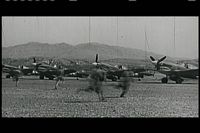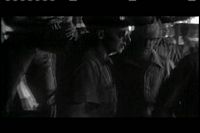
Dogfights: Flying Tigers
The Flying Tigers were a group of volunteer US airmen who helped the Chinese battle the Japanese. This film is about Tex Hill and John Alison who flew P-40 Tomahawks.
 |
Ten Japanese Ki-27 Sally bombers flying towards a city in southern China on Dec. 20, 1941. They encounter four of the flying tigers.
 |
Four P-40 Tomahawks attack the bombers.
 |
The Japanese bombers drop their bombs to get rid of them and then turn for home.
 |
Ten more Tomahawks appear and jump the bombers.
 |
The nose design of the Tomahawks.
 |
This is extremely well done graphics on this disc as a Tomahawk comes up behind one of the bombers and opens fire. Four of the bombers were shot down.
 |
A Chinese newspaper came up with the term “flying tigers” to describe the men and their planes.
 |
The Japanese adopted a policy for China called the 3 Alls: Kill all, Loot all, Burn all.
 |
This was the kind of planes that the Chinese were flying. Notice that they are the old biplanes which didn't stand a chance against the more modern single-wing Japanese fighters.
 |
The film also interviews people from the Flying Tigers group. The head of the group had been asked to resign from the US military since he got too many people mad at him in pushing for more fighter plane development. He then went to China and started up the Flying Tigers group. They were to defend the Burma Road. They were also well paid, for the times.
 |
The design in color.
 |
A few days after the first attack the Flying Tigers hit another group of Japanese planes, downing eleven for sure, and possibly five more.
 |
In an attack on December 25th, they down 24 more Japanese planes.
 |
January 3rd, 1942. Tex Hill and two other pilots attack a Japanese airfield in Thailand.
 |
They strafe the airfield as shown in more of these really good graphics.
 |
A Ki-27 Nate.
 |
Tex Hill shoots the Nate down as it was attacking another of the Flying Tigers.
Tex Hill shoots down his second plane of the battle. The film describes the specific tactics used by the Flying Tigers. Four bombers were destroyed on the ground, and four fighters destroyed in the air during the attack.
 |
In six months they downed around 130 Japanese planes.
 |
Once the war was under way, the Flying Tigers were no longer needed per se, and the whole thing was reorganized. To show their thanks, the US military told the pilots that they could either stay with the new Chinese air group, or they could go home and be immediately drafted into the Army.
July 29, 1942. The Japanese are doing another bombing mission, trying to destroy the reorganized Flying Tiger planes on the ground. Tex Hill and John Alison decide to take them on at night. Six Japanese bombers were involved in the raid.
The video shows the tactics Alison had to use when he was fired on.
Alison shoots down the second of three bombers that were firing on him.
He then shoots down the third bomber.
July 30, 1942.The Japanese stage a major raid on the airfield, complete with fighter escorts.
The fighters they took on were the Oscar fighters. The Tomahawks were outnumbered around 3:1 in the fight.
The Tomahawks had more powerful weapons though. 15 of the Japanese fighters are shot down in the raid.
The Flying Tigers were also used for bomber escorts, and for strafing ground targets.
On his last mission, Alison has to try and stop some U.S. bombers from being jumped by Japanese fighters.
1000 Japanese crafts, over 184 merchant ships, 817 bridges, 1225 locomotives, 60,000 Japanese troops dead: the final total of the Flying Tigers.
Main Index
Japan main page
Japanese-American Internment Camps index page
Japan and World War II index page
|